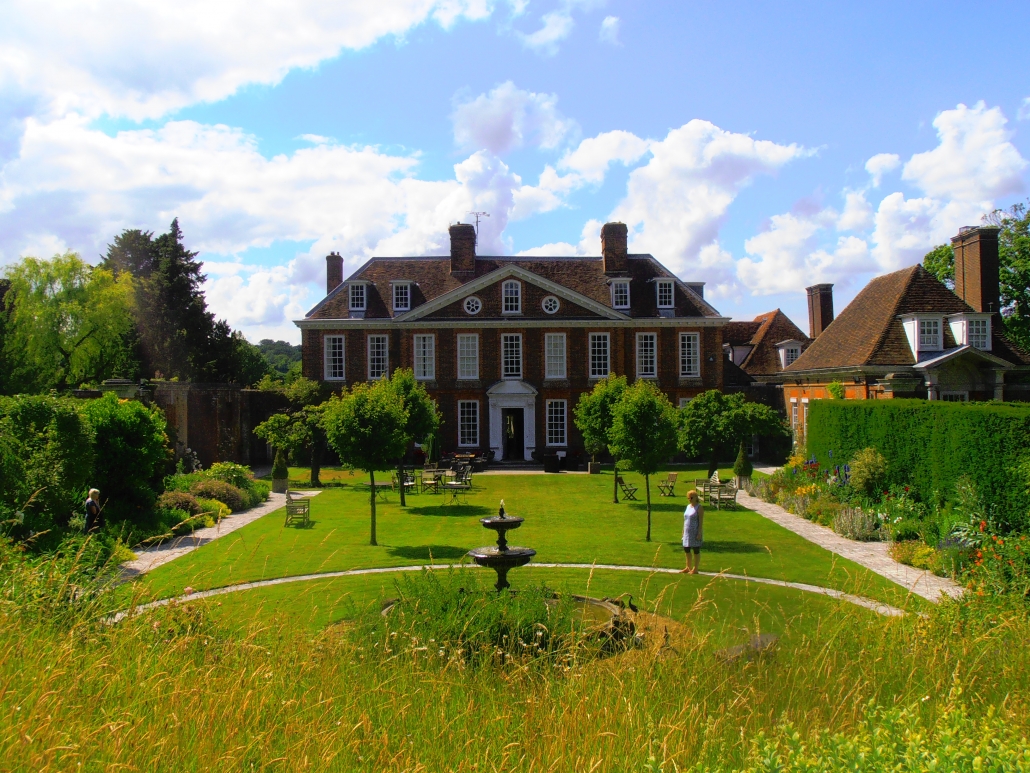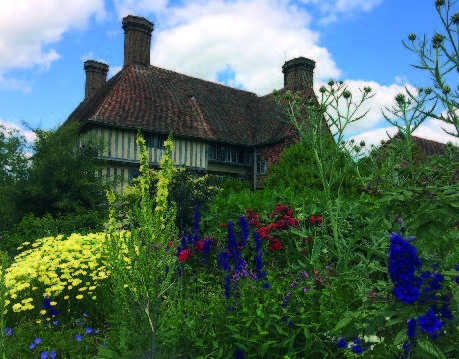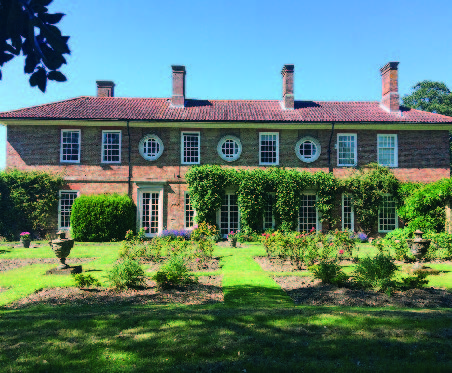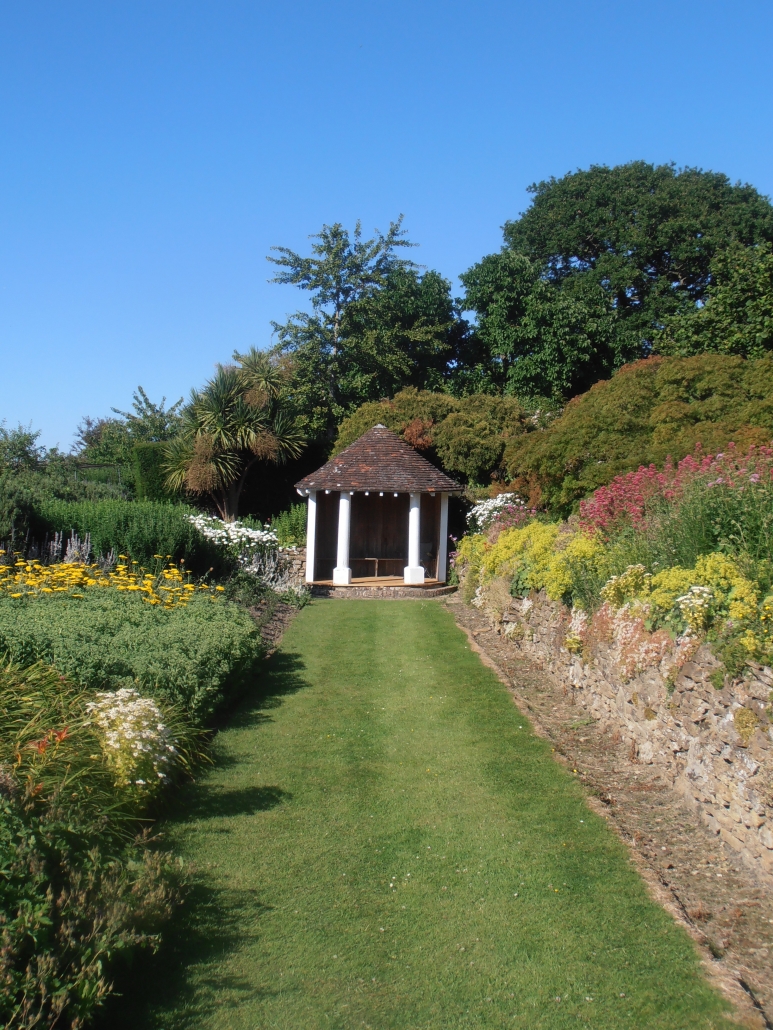Barham Court’s Queen Anne facade © Rebecca Lilley
Tour of Edwin Lutyens’s Barham Court, Kent in his Queen Anne Style
Tuesday, 2 July, 2019
By Rebecca Lilley
The alterations made by Edwin Lutyens in 1911 to Barham Court, near Canterbury, Kent, a mansion whose oldest section was built in 1735, are beautiful examples of Edwin Lutyens’s Queen Anne style. Indeed, the principal garden elevation is one of these and was only subtly altered by Lutyens. He was commissioned by the house’s then-owner, Nathaniel Evelyn Stainton, to refurbish and enlarge the house; Lutyens’s most notable contribution was the creation of a large, curved entrance facade, facing Rectory Lane. Our group was told that Stainton requested the latter in order to prevent parishioners from walking across the garden immediately outside the house on their way to church and back.
Although the house is now divided into flats, Lutyens’s vision for it has largely been retained. Mr Cox, who so kindly showed us around, has gradually bought more and more of the property as parts of it have come onto the market. When we visited, he and his wife owned the basement, ground and first floors of the main block and the single-storey northeast wing, which Lutyens created as a living room. Their main entrance is also via Lutyens’s grand front door in the centre of the concave wall, facing the lane.
Modern interventions have been cleverly designed to minimise their impact on the overall design, and include a hidden cupboard in the front hall and an extension of built-in cupboards in one bedroom. Meanwhile, the Old Hall’s main staircase has been beautifully restored by Mr Cox and the long, first-floor balustrading — lost when the second-floor flat was created — has been meticulously replaced, replicating the original design.
The gardens, too, have been extensively renovated to show off the house in its setting, as Lutyens originally intended. The planting is delicate, airy and full of pastel colours — something Jekyll would have appreciated, I am sure, and plenty of Lutyens’s original features could be found here, from brickwork resembling millstones to tiled steps and yew hedges. The loggia at the end of the northeast wing, to which Lutyens added a door on the rear wall, survives. This acts as the garden door from the drawing room.
On the day of the tour, it was beautifully sunny, so it was difficult to tear ourselves away from the house and garden, especially when we were all enjoying a good cup of English tea and homemade biscuits. We are all very grateful to Mr and Mrs Cox for a delightful tour of their beloved home, which is not normally open to the public. Readers may be interested to know that you can stay in the house with Airbnb.
Trust members at Great Maytham © Rebecca Lilley
Tour of Two Lutyens Houses in Kent – The Salutation and Great Maytham
Tuesday, 2 July and Wednesday, 3 July, 2019
By John Comins
By the time Lutyens designed these houses, he was well into his Wrenaissance period and had adapted his style to buildings with Georgian proportions and motifs. The Salutation and Great Maytham display the effects of his conversion on two contrasting scales and to different degrees. The former was a modest family home, the latter a massive political statement, which provides an absorbing comparison of how Lutyens met his clients’ differing requirements for a country house and garden.
A concern for a brother’s health may have inspired the Farrer brothers to build The Salutation, a country retreat very close to the sea at Sandwich. He may have benefited from this, but later owners have had cause to regret the location. This was made clear from our guide’s account of the inundation that occurred here in 2013: a combination of high tides and dismantled flood defences resulted in the almost total destruction of its garden, where six feet of floodwater left a legacy of deposited salt and ruined plantings. The house, however, was saved, thanks to its position on slightly higher ground.
Considering that several seasons were lost in the process of desalinisation, the garden’s restoration has been truly remarkable. Great care has been taken to retain Lutyens’s basic design although the details of the original planting have been lost and there is, incidentally, no record of Jekyll’s involvement. The yew hedges dividing the bowling green from the main garden have been revived and careful thought has been given to planting. This would accord with the Lutyens vistas and the need to give a long show throughout the summer.
The chosen site for the house, approached through the narrow lanes of a seaside town, gave little opportunity for pretension but Lutyens contrived to give a considerable sense of grandeur to this compact area of some four acres.
The house has been through many trials. However, the present owners, in converting it to an hotel, have provided the high polish it deserves. It carries many characteristics of Lutyens’s country-house style in the immediate prewar period — massive chimneys, the contrasting profiles of the three main façades, the perfection of the rubbed brick arches and Georgian symmetry. The seven-bay entrance front and sweep of steps might be expected to anticipate an equally grand hall. Yet this isn’t a large space; neither are the adjoining lobbies but, as one climbs the stairs, the volume augments, revealing contrasts and surprises. The Salutation was built for bachelor brothers, which perhaps explains the relatively modest proportions of the main reception rooms in relation to the house’s size. But, opening to the south, these take in the full glory of the secluded walled garden.
On our way to Great Maytham, I remembered that, in 1911, Lutyens attempted — in vain — to persuade his wife to visit it: “It is a delicious spot but I am afraid you would not face it”.
Indeed, delicious may not be one’s first reaction to this monumental house Lutyens designed for the Liberal politician, Harold John Tennant. It has not avoided critical comment. One of Lutyens’s biographers thought its Classicism “conventional and pompous”. Another commentator described it as one of his less remarkable works. But on our visit, architect Sir Terry Farrell, who occupies one of its large apartments, enthusiastically defended it. He has contributed time, expertise and objects to his apartment’s restoration and decoration. Readers will remember his recent article in the Trust’s newsletter and his perceptive analysis of the house acting as a screen between two contrasting landscapes and dynamic variation in rooflines and facades. His admiration for Lutyens’s work was admirably expressed.
The house’s size and mass are at first sight slightly overpowering. After entering the grounds through the stable block, itself full of subtle detailing, a straight drive through a small park ends with the house square on 15 bays of regular fenestration. This regularity is pointed up by the three emphatic door cases. Closer inspection of the imposing grey-brick walls shows them lightened and softened by an apparently random addition of red bricks. Of course, such a magical effect would hardly have been random but one wondered how it was achieved without giving the builders a detailed specification. Someone helpfully suggested that a trial wall might have been built and then, with Lutyens’s approval, the final decisions were left to the builders.
The motivation for the commission was, in Terry’s opinion, both political and familial. As a member of Asquith’s cabinet with the right budget for it, Tennant desired a place appropriate for the house-party gatherings of late-Edwardian England, complete with family quarters and an ample supply of lavatories. Lutyens gave him a place and grounds worthy of the great Whig heritage and it was perhaps the first that he designed for both cars and horses.
The garden front, now with the fenestration increased to 17 bays, looks out on to great enclosures adorned with walls, pools, steps and flower borders, all in a fine state of maintenance. Suited to the extensive promenades enjoyed by the kind of weekend guests that people the romances of Henry James novels, it’s in complete contrast to the intimacy of The Salutation’s grounds. At one point during the tour, the question of replacing the shutters on the garden front was raised but Terry confirmed that the decision had been taken not to do so.
Terry also told us that the house had adapted well to the needs of its many residents in providing 10 apartments in the main house and a further 10 in the adjoining buildings, so it is perhaps as fully occupied now as it was when the Tennant family, guests and staff thronged the site.
Great Dixter © Joanne Mirzoeff
Wittersham House © Joanne Mirzoeff
Garden at Wittersham © Rebecca Lilley
Tour of Lutyens Houses Great Dixter, East Sussex and Wittersham House, Kent
Wednesday, 3 July, 2019
By Joanne Mirzoeff
At first, Great Dixter appears quintessentially English as if it had nestled in this quiet corner of East Sussex for centuries. You are captivated by the delightful house surrounded by its abundant garden. However, all is not what it seems.
As we gathered on the front lawn one sunny day in July, our guide Charles Hind explained how, in 1910, Nathaniel Lloyd, who owned a colour-printing firm, bought the original 15th-century timber-framed hall house to create a comfortable home in which to raise a family. He engaged the services of Edwin Lutyens and together they motored around the area seeking inspiration from the local vernacular architecture. On discovering the remains of a derelict, 16th-century, timber-framed house, Lutyens persuaded Lloyd to buy it and re-erect it on a raised brick base to the southeast of the original house at Dixter. Lutyens then linked the two historic structures under the sweeping tiled roof with a simple Arts and Craft brick and tile-hung east wing — superbly executed with a careful choice of local materials to articulate the old with the new.
Great Dixter is most famous for its gardens and Lutyens designed much here with a layout that enveloped the surrounding farm buildings, compartmentalising them for different uses. The result is sublime and, as we strolled around the gardens, the changing architectural face of the house was mesmerising. Familiar Lutyens touches are evident with the circular stone steps and beautiful walling and archway but it was the Lloyd family who inspired the planting. Nathaniel contributed much to the design and his wife, Daisy, a great plantswoman, passed her passion and practicality on to her son, Christopher, the innovative gardener who opened the property to the public.
We had the privilege of a private tour inside the house where Charles showed us how Lutyens maintained a light touch, restoring where possible, reinstating where appropriate and making sympathetic additions with superbly executed vernacular details where necessary. It was a privilege and delight to visit Great Dixter and our tremendous thanks go to Charles for his wonderful tour.
From there, we progressed to Wittersham House in Kent, our final visit of the day. Lutyens had previously designed Greywalls in East Lothian for the Hon Alfred Lyttelton MP in 1901 but, when the costs of its upkeep became excessive, the Lytteltons bought an old unremarkable rectory called Wittersham House and invited Lutyens to remodel it. In 1907, Lutyens entirely altered the exterior through the introduction of a hipped, pantiled roof with wide eaves, cornices, a recessed pedimented entrance porch, round windows alternating with traditional sash windows on the southeast elevation, a central courtyard and an outdoor room. Despite there being only a three-year gap between the two projects, the finished sophisticated neo-Georgian house could not be more different in architectural style from Lutyens’s more Arts and Crafts vernacular aesthetic at Great Dixter. In both cases, Lutyens’s work is executed with fine detail and demonstrates the inventive breadth of his architectural talents.
We were graciously hosted by the current owner, Mrs Mallet, and her son, Stephen, who gave an informative tour around their part of the house and gardens. They explained how they had subdivided their home in the 1970s, creating a number of self-contained flats to allow them to continue living there. Many of the rooms have wonderful views on to the charming gardens with wide lawns and paths leading to the Lutyens-designed pergola and summerhouse. Our visit concluded with delicious home-made elderflower cordial drinks in the garden, provided by our excellent hosts.






 Country Life
Country Life Keith Allan
Keith Allan